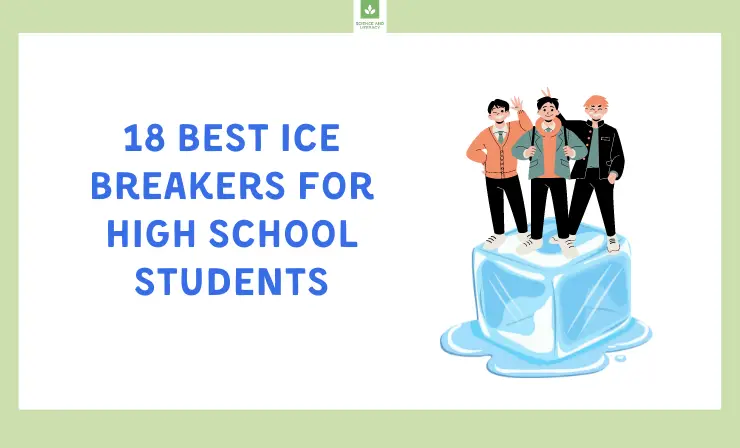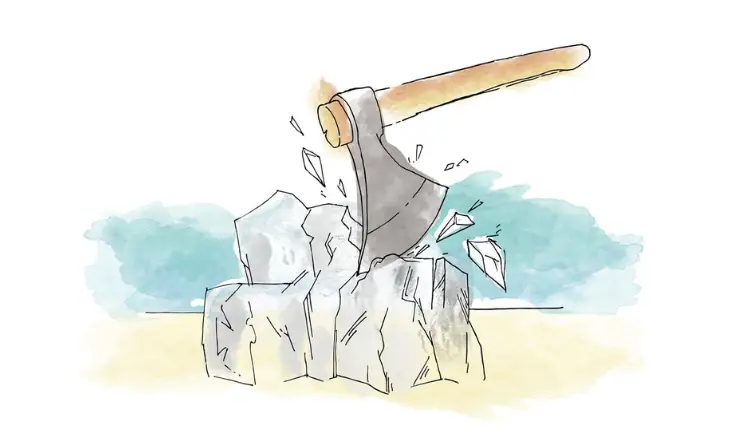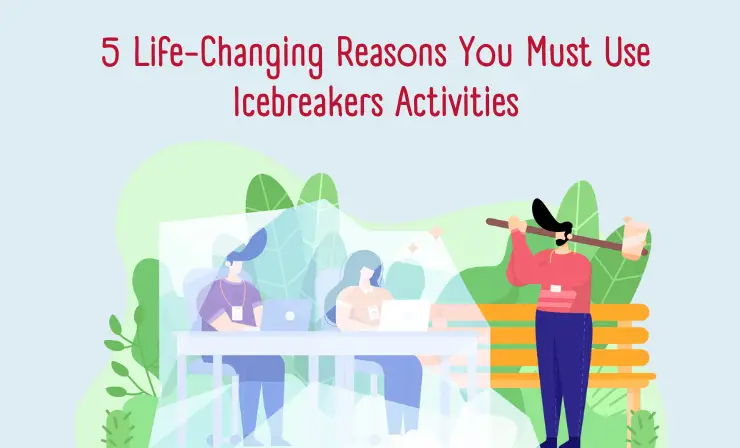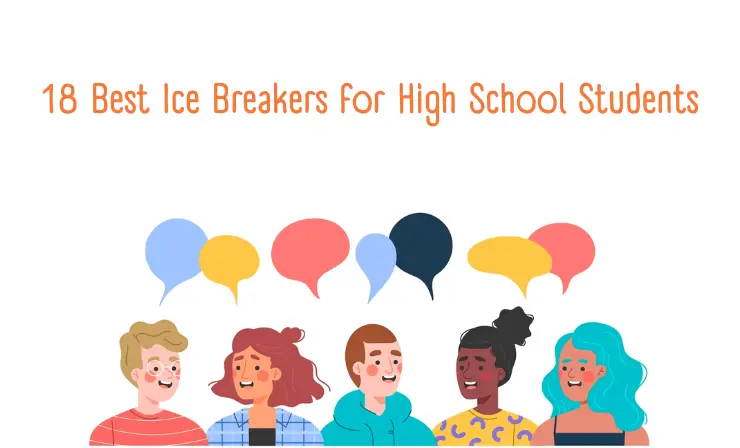High school is an exhilarating mix of excitement and nerves, where new experiences beckon in bustling corridors and classrooms open doors to growth. Amid this, a universal desire to connect weaves through the vibrant tapestry of high school life, making it a transformative journey filled with the anticipation of meaningful relationships and the uncovering of potential.

Enter icebreakers – essential tools that weave connection and inclusivity throughout the high school experience. These activities transcend casual games, becoming the foundation for lasting friendships, bridging the gap between unfamiliarity and familiarity, and unlocking high school’s rich tapestry in all its hues.
Imagine stepping into a high school classroom on the first day of the academic year. Whether you’re a dedicated educator, a student eager to connect with classmates, or a club organizer shaping a vibrant group, these icebreakers cater to diverse needs. They form a toolkit of connection, creating an atmosphere where everyone thrives, powered by an unexpected synergy.
As you join in these icebreakers, witness their transformation – see how they dissolve initial hesitations, replacing them with shared laughter and the joy of discovery. Feel the surge of energy as connections form and barriers crumble. These icebreakers offer students the golden opportunity to share stories, embracing the diverse narratives of their peers and forming bonds that stretch beyond the classroom.
Their impact hinges on aligning them with your high school audience’s interests and scale. Like a skilled conductor tailors a performance, adapt these activities to your group’s unique dynamics, ensuring they remain captivating, accessible, and perfectly tailored to the gathering’s size.
Let’s dive into this treasure trove of icebreakers together, armed with the knowledge that they hold the potential to create unforgettable high school moments. With these icebreakers as our guide, we embark on a daily journey of discovery, growth, and lasting memories.
APE tip of the week: From the beginning, take time to get to know your students (ice breakers, IEPs, group activities, etc.) … the “honeymoon phase”! #adaptedpe #apechatter #adaptedphysicaleducation
— WPU PHYSICAL EDUCATION (@wpu_pe) January 25, 2019
After reading this article, you’ll get to know about:
- What Exactly Is An Icebreaker?→
- 5 Life-Changing Reasons You Must Use Icebreakers Activities with your High School Students→
| 1. Human Bingo |
|
| 2. Two Truths and a Lie |
|
| 3. The Great Question Wall |
|
| 4. Speed Friending |
|
| 5. Common Bond |
|
| 6. Would You Rather |
|
| 7. The Name Game |
|
| 8. In the Spotlight |
|
| 9. Group Juggle |
|
| 10. Share the Emoji |
|
| 11. One-Minute Compliments |
|
| 12. Reverse Charades |
|
| 13. Human Knot |
|
| 14. Creative Collage |
|
| 15. One-Word Story |
|
| 16. M&M Ice Breaker |
|
| 17. The Memory Wall |
|
| 18. Pictionary Telephone |
|
What Exactly Is An Icebreaker?
An icebreaker is a swift and engaging activity, strategically employed in the classroom to foster connections between students and teachers. Its purpose spans various scenarios, from commencing a fresh session or term to bridging the gap between prior and upcoming course activities. The paramount focus is on crafting an enjoyable experience, ensuring students feel at ease within the classroom. Often referred to as “warmer activities” these icebreakers play a pivotal role in setting the tone for positive interactions.

Icebreakers, much like the ever-evolving world around us, adapt and transform. Seek out contemporary games that seamlessly align with the classroom’s objectives. Be wary of outdated concepts, for unless they seamlessly integrate with the current topic, they might feel foreign and disconnect from the students’ context.
5 Life-Changing Reasons You Must Use Icebreakers Activities with your High School Students
Discover the compelling reasons why integrating icebreakers into your high school classroom is a game-changer. Crafting a comfortable learning environment is paramount, and from my experience teaching math to high school students, early utilization of icebreakers is essential. It prevents students from being anonymous by the end of the year, fostering connections instead of referring to each other as “the kid in front” or “the one on their phone.”

You’ll explore the top 5 life-changing reasons for using icebreakers with your high school students to enhance academic success.
Whether it’s the beginning of the school year or after an unexpected break, icebreakers are ever-relevant. The impact reaches beyond initial introductions; it sets the tone, re-establishes focus, and helps you relearn students’ names, ensuring a dynamic classroom environment.
1. Discover Your Students’ Personalities
A simple icebreaker activity, like the beach ball sharing game, reveals a wealth of information about your students’ personalities. Introverts, extroverts, potential classroom dynamics, and individual interests subtly come to the surface, setting the stage for a deeper understanding of each student.
2. Build Relationships
Icebreakers form the foundation of classroom relationships, creating a safe, non-threatening environment. This camaraderie encourages collaborative learning, study groups, and students helping each other, leading to an atmosphere where everyone thrives, learns, and contributes.
3. Promote Creativity
Icebreakers should be engaging and fun. They encourage interaction and team spirit, boosting student participation and learning outcomes. When students feel part of a team, their motivation and academic achievement increase.
4. Social and Emotional Health
In an era of isolation through technology, icebreakers bridge the gap, connecting students in a community. This sense of belonging fosters active participation, group activities, and collaborative learning, positively impacting their social and emotional well-being.
18 Best Ice Breakers for High School Students

1. Human Bingo
Human Bingo is a classic ice breaker that goes beyond mere introductions. It encourages students to interact on a deeper level and discover common interests, hobbies, and experiences. The beauty of this game lies in its versatility. Teachers can tailor the bingo cards to suit specific themes, such as “Summer Adventures” or “Favorite Books,” to make the game even more engaging. This not only helps students learn about each other but also sparks intriguing conversations, making it an excellent ice breaker for the beginning of the school year or the start of a new club.
What You Will Need: Prepared bingo cards, pens or markers.
Set-Up: Distribute bingo cards to each student as they enter the classroom.
How to Play: Students mingle, finding classmates who match the statements on their bingo cards. When a student finds someone who fits a description (e.g., “Has traveled to another country”), they ask that student to sign the corresponding square. The first student to complete a row or column shouts “Bingo!” and wins a small prize, fostering a sense of accomplishment and creating an environment of friendly competition.
Observe the Bingo Ice Breaker in Action! Join this engaging video to witness a comprehensive explanation of the rules and a lively demonstration of this enjoyable icebreaker involving enthusiastic high school students.
2. Two Truths and a Lie
This ice breaker is a fantastic way to delve deeper into the lives of high school students. It’s engaging, thought-provoking, and often leads to laughter and surprise. By sharing two true statements and one false statement about themselves, students open up and reveal intriguing facets of their personalities. This activity also encourages critical thinking, as participants must discern the lie from the truths. It’s a fantastic ice breaker for building connections and sparking conversations in a fun and relaxed setting.
What You Will Need: None.
Set-Up: Arrange students in a circle or small groups.
How to Play: Each student takes turns stating two true statements and one false statement about themselves. The others must guess which statement is the lie. Not only does this exercise help students get to know each other, but it also builds trust within the group as participants share personal details, fostering a sense of community.
This video provides an instructional guide on playing ‘Two Truths and a Lie,’ presenting the rules and showcasing the icebreaker in action.
3. The Great Question Wall
High school is a time for exploring ideas, expanding horizons, and questioning the world around us. The Great Question Wall is an ice breaker that taps into students’ curiosity, encouraging them to ask thought-provoking questions and engage in meaningful discussions. By providing a safe space for questions, this activity promotes critical thinking, stimulates curiosity, and helps students develop communication skills.
What You Will Need: Large sheets of paper, markers.
Set-Up: Hang the large sheets of paper on the walls with bold headings like “Ask Me Anything” or “What If?”
How to Play: Throughout the first few days of school or club meetings, students can write any question they have on the paper. Others can respond with their thoughts, leading to open dialogue and fostering connections. This activity not only allows students to share their ideas but also gives them the opportunity to listen to and learn from their peers, creating a dynamic and intellectually stimulating environment.
This video offers a range of question ideas, serving as a valuable source of inspiration for students seeking icebreaker prompts.
4. Speed Friending
Making friends in high school is a top priority for many students, but initiating conversations can be challenging. Speed Friending is a clever ice breaker that takes inspiration from speed dating, providing students with a structured and time-efficient way to meet new people. It’s perfect for the beginning of the school year, club gatherings, or any event where students need to get to know each other quickly.
What You Will Need: Chairs arranged in pairs, a timer.
Set-Up: Arrange the chairs in two lines, facing each other, with enough space for students to move.
How to Play: One line of students stays seated, while the other line rotates every 60 seconds. During each interaction, students have a brief conversation with the person they’re facing. This format allows everyone to cover a lot of ground in a short time, leading to multiple introductions and potentially forming the basis for new friendships. It’s a fantastic ice breaker for creating a sense of familiarity and breaking down social barriers.
This video demonstrates the gameplay of the Speed Friending ice breaker, showcasing its execution and illustrating how it can be effectively conducted.
5. Common Bond
Finding commonalities is a powerful way to bridge the gap between students. Common Bond is an ice breaker that emphasizes shared experiences, hobbies, and interests. It helps students recognize that, despite their differences, they have much in common. This activity not only fosters connections but also encourages a sense of belonging and creates a positive atmosphere.
What You Will Need: None.
Set-Up: Divide students into small groups.
How to Play: Each student takes turns sharing a unique fact about themselves. If another student in the group has a similar experience, they connect, whether it’s sharing a love for a particular book series, a passion for a specific sport, or having visited the same place. This ice breaker promotes inclusivity and shows students that there are others who share their interests, providing a strong foundation for building relationships.
This video illustrates the mechanics of the Common Bond icebreaker, a enjoyable activity that aids students in discovering shared interests. Watch how this icebreaker can be played and enjoy its engaging nature.
6. Would You Rather
Engaging in lighthearted debates and exploring imaginative scenarios is a fantastic way to spark conversations and get students talking. “Would You Rather” is a fun and interactive ice breaker that encourages students to express their preferences, ponder hypothetical situations, and engage in friendly discussions.
What You Will Need: None.
Set-Up: Gather students in a circle.
How to Play: One student poses a “Would You Rather” question (e.g., “Would you rather have the ability to fly or be invisible?”). Each student takes turns answering the question and explaining their choice. The discussions that arise from these scenarios can lead to laughter, reveal interesting perspectives, and provide insights into each student’s personality.
This video provides ideas and variants for the ‘Would You Rather’ icebreaker, offering suggestions to help students initiate the game and offering creative inspirations.
7. The Name Game
Remembering names can be challenging, especially in larger high school settings. The Name Game is a classic ice breaker that not only helps students learn each other’s names but also adds an element of fun and creativity to the process.
What You Will Need: None.
Set-Up: Form a circle with all the students.
How to Play: The first student says their name and a word that describes them, starting with the same letter as their name (e.g., “I’m Friendly Fiona”). The next student repeats the first student’s name and word, then adds their own (e.g., “Friendly Fiona, and I’m Energetic Ethan”). This continues around the circle. Not only does this ice breaker help students remember names, but it also encourages them to come up with creative adjectives that describe their personalities or interests.
This video showcases an alternative version of the Name Game Icebreaker, offering a simpler approach. Participants simply repeat the name and gesture demonstrated by another student, making it an easy and effective icebreaker.
8. In the Spotlight
High school is a time when students begin to discover their talents, passions, and unique qualities. In the Spotlight is an ice breaker that celebrates individuality and gives students the chance to shine, boosting their confidence and creating a supportive environment.
What You Will Need: None.
Set-Up: Arrange a stage area in the classroom.
How to Play: Students take turns coming to the “spotlight” to showcase a talent, share an interesting fact about themselves, or talk about something they’re passionate about. This activity can include anything from singing a song to demonstrating a skill, or even sharing a significant life experience. The rest of the group listens attentively, applauds, and shows appreciation for each student’s contribution. This ice breaker not only fosters a sense of community but also encourages students to celebrate and support each other.
9. Group Juggle
Collaboration and teamwork are essential skills that high school students need to develop. Group Juggle is a physical ice breaker that requires participants to work together, enhancing communication and coordination while providing a fun and active experience.
What You Will Need: Soft ball or stuffed animal.
Set-Up: Form a circle with students standing close together.
How to Play: One student starts with the ball and says their name. They toss the ball to another student across the circle while saying that student’s name. The ball continues to be passed, with each student repeating the name of the person they’re throwing the ball to. This exercise helps students learn each other’s names while promoting teamwork and cooperation. The goal is to remember everyone’s name and keep the ball moving without dropping it, creating a sense of accomplishment as the group successfully navigates the challenge together.
This video showcases an alternate variation of Group Juggle, offering a potentially even more enjoyable experience. Discover how this icebreaker can be played with a twist and experience the potential for added fun.
10. Share the Emoji
In today’s digital age, emojis have become a universal language. Share the Emoji is an ice breaker that leverages the popularity of emojis to encourage students to express their emotions, interests, and experiences.
What You Will Need: A list of common emojis.
Set-Up: Provide a list of common emojis.
How to Play: Each student chooses an emoji that represents their mood, a hobby, a favorite activity, or something interesting about them. They explain their choice to the group, sparking conversations about emotions, interests, and experiences. This activity allows students to communicate non-verbally while offering insights into their personalities. Additionally, it’s a great way to embrace technology and incorporate modern elements into traditional ice breakers.
This video presents a modified version of the Share the Emotion icebreaker. It offers a lighter approach that may suit your needs. In this version, students receive emojis representing emotions and express these emotions to their peers, while the others try to guess the corresponding emojis. It’s a delightful and engaging activity to enhance connections.
11. One-Minute Compliments
Building a positive and supportive environment is crucial in high school. One-Minute Compliments is an ice breaker designed to boost self-esteem, foster positivity, and create a sense of appreciation within the group.
What You Will Need: Timer.
Set-Up: Arrange students in a circle.
How to Play: Each student has one minute to give compliments to the person on their right. When the timer goes off, students rotate, and the process continues. Compliments can be related to appearance, personality, talents, or even small acts of kindness observed. This simple exercise not only lifts everyone’s spirits but also encourages students to recognize and appreciate each other’s unique qualities. By the end of the activity, students feel valued and more connected, setting the stage for a supportive and encouraging atmosphere.
This video serves as an excellent precursor to the One-Minute Compliments icebreaker. It introduces the theme of giving and receiving compliments, making it a perfect starting point for exploring the topic. Incorporate this video to set the stage for the subsequent icebreaker and initiate a thoughtful discussion on the value of compliments in fostering positive interactions.
12. Reverse Charades
Charades gets a fun twist with Reverse Charades, an exciting and energetic icebreaker that flips the classic game on its head. In this version, instead of one person acting out a word or phrase while the others guess, an entire team works together to act out the word or phrase while one person guesses. This collaborative approach adds a lively element of teamwork, hilarious interpretations, and fast-paced excitement.
What You Will Need: A list of words or phrases, a timer.
Set-Up: Divide students into teams of at least 3-4 members.
How to Play: One person from each team takes on the role of the guesser, while the rest of the team members work together to act out the chosen word or phrase. The guesser has a limited time to figure out the answer based on their team’s combined performance. Teams rotate the guesser role after each round, allowing everyone to participate. Reverse Charades encourages teamwork, creativity, and laughter as teams come up with creative and sometimes unconventional ways to convey the words or phrases. It’s a fantastic icebreaker that promotes cooperation, energizes the atmosphere, and ensures that everyone is actively involved.
Explore the video to witness the humor and entertainment of the Reverse Charades icebreaker. This activity promotes unity among participants, making it a delightful way to spend time together.
13. Human Knot
Problem-solving, cooperation, and physical coordination are key aspects of the Human Knot ice breaker. This activity requires students to work together to untangle a human knot, making it an excellent team-building exercise.
What You Will Need: None.
Set-Up: Students stand in a circle and put their hands in the center, grabbing the hands of two different people across from them.
How to Play: Without letting go, students work together to untangle the “human knot” and form a circle again. The challenge lies in figuring out how to move without releasing hands or creating a new knot. As students communicate and collaborate, they develop problem-solving skills and build a sense of unity within the group. It’s a physical ice breaker that also strengthens bonds and encourages teamwork.
Observe this video to grasp the mechanics of the Human Knot icebreaker. Witness the game in action as it demonstrates how to execute this activity with students. The video offers a visual representation, showcasing how to arrange participants for a successful Human Knot icebreaker experience.
14. Creative Collage
Self-expression is essential in high school, and Creative Collage is an artistic ice breaker that encourages students to share their interests, goals, and favorite things in a visual and creative way.
What You Will Need: Magazines, scissors, glue, large paper or cardboard.
Set-Up: Provide art supplies and space to work.
How to Play: Students create collages using magazine cutouts, images, and words that represent their interests, aspirations, and the things that matter to them. Afterward, they share their collages with the group, explaining the meaning behind their choices. This activity not only showcases students’ creativity but also leads to meaningful discussions as they explain the significance of each element in their collages. It’s a beautiful way for students to connect through shared interests and aspirations.
This video serves as an idea generator for the Creative Collage icebreaker. Use it as a pre-activity resource to provide students with additional inspiration for their collage creations.
15. One-Word Story
Storytelling is a powerful way to engage students’ imaginations and creativity. One-Word Story is a captivating ice breaker that requires participants to think on their feet and contribute to a collective narrative.
What You Will Need: None.
Set-Up: Gather students in a circle.
How to Play: The first student starts the story with one word (e.g., “Once”). The next student adds another word (e.g., “upon”), and the story continues, with each student contributing a single word. The goal is to create a coherent and entertaining story together. This activity not only encourages quick thinking but also leads to laughter and imaginative narratives. It’s an excellent way to spark creativity and collaborative storytelling among high school students.
This video demonstrates the implementation of the One-Word Story icebreaker in a humorous manner. Encourage students to utilize intonation to enhance the enjoyment of the activity.
16. M&M Ice Breaker
Combining delicious treats with ice breaker activities is a surefire way to capture students’ attention and create a memorable experience. The M&M Ice Breaker is a colorful and tasty game that encourages students to share fun facts about themselves while enjoying a sweet treat.
What You Will Need: A bag of M&M candies.
Set-Up: Distribute M&M candies to each student.
How to Play: Each student takes turns sharing a fun fact about themselves for each color of M&M they have. For example, red could be a favorite hobby, green a favorite book, and so on. The variety of colors and the spontaneity of the activity make it engaging and lighthearted. As students share their facts, they also learn about each other’s preferences, creating connections and sparking conversations over a shared love for candy.
This video presents a demonstration of the M&M Ice Breaker activity. Observe the implementation process to gain insights.
17. The Memory Wall
Memories shape who we are, and sharing positive experiences can bring people closer together. The Memory Wall ice breaker provides students with a platform to express gratitude, reflect on significant moments, and bond over shared experiences.
What You Will Need: Sticky notes, markers.
Set-Up: Create a designated “Memory Wall” with a large piece of paper or bulletin board.
How to Play: Throughout the first few days of school, students write down memorable experiences or something positive that has happened to them on sticky notes. They attach these notes to the Memory Wall, creating a colorful and uplifting display. This activity fosters gratitude, showcases the positivity within the group, and helps students recognize the good moments in their lives. It also provides an opportunity for students to engage in conversations about their experiences, creating connections through shared joys.
Watch the video showcasing the creative execution of the Memory Wall concept. Use it as inspiration for your own unique interpretation of this icebreaker activity.
18. Pictionary Telephone
Combining the creativity of Pictionary with the element of surprise from the telephone game, Pictionary Telephone is a unique ice breaker that results in hilarious interpretations and laughter.
What You Will Need: Paper, pens.
Set-Up: Form a line of students.
How to Play: The first student is given a word or phrase to draw. They show their drawing to the next student, who then tries to describe the drawing in words to the following student. This process continues, alternating between drawing and describing. The last student reveals the final drawing, leading to humorous interpretations as the original word or phrase evolves through each participant. This ice breaker not only encourages creativity but also creates a sense of camaraderie as students bond over the amusing results.
Discover the video tutorial for a lighter version of the Pictionary Telephone icebreaker. Learn the rules and enjoy this fun activity.
Useful Resources
- 10 Best Virtual Icebreakers for High School Students
- Fun Icebreaker Questions for High School Students
- Establishing a Positive Classroom Climate
Conclusion
Incorporating these ice breakers into your high school experience can greatly enhance the sense of community, foster friendships, and create a positive atmosphere. Each activity serves a unique purpose, whether it’s learning about each other’s interests, building teamwork skills, or celebrating individuality. So go ahead and break the ice with these fantastic options, and watch as your high school experience becomes even more enjoyable and memorable!
- Overview of 22 Low-Code Agencies for MVP, Web, or Mobile App Development - October 23, 2024
- Tips to Inspire Your Young Child to Pursue a Career in Nursing - July 24, 2024
- How Parents Can Advocate for Their Children’s Journey into Forensic Nursing - July 24, 2024
